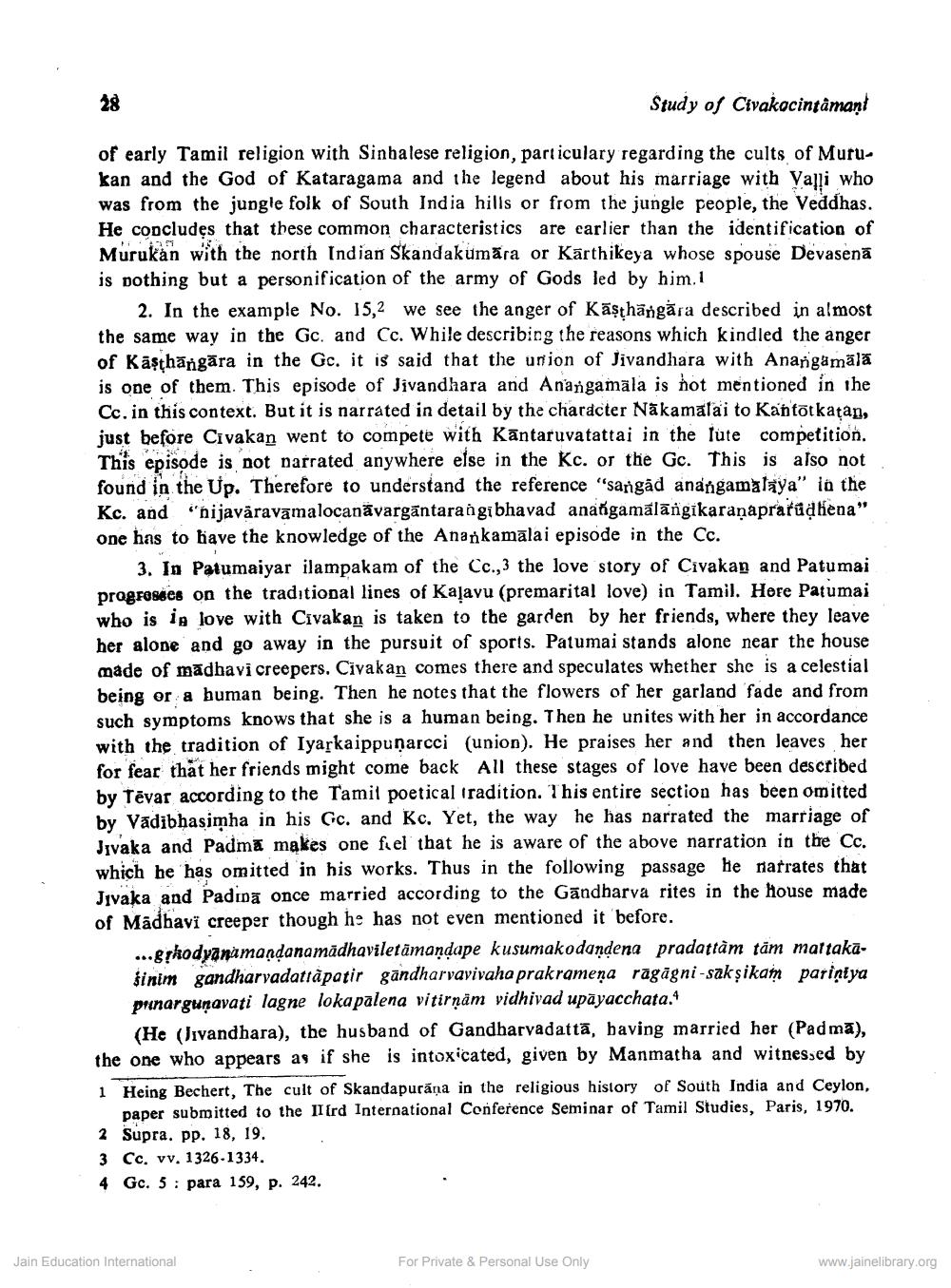________________
28
Study of Civakocintamant
of early Tamil religion with Sinbalese religion, particulary regarding the cults of Murukan and the God of Kataragama and the legend about his marriage with Vaļļi who was from the jungle folk of South India hills or from the jungle people, the Veddhas. He concludes that these common characteristics are carlier than the identification of Murukan with the north Indian Skandakumăra or Karthikeya whose spouse Devasenā is nothing but a personification of the army of Gods led by him. 1
2. In the example No. 15,2 we see the anger of Kāşthängāra described in almost the same way in the Gc. and Cc. While describing the reasons which kindled the anger of Kāşthāngāra in the Gc. it is said that the union of Jivandhara with Anangamālā is one of them. This episode of Jivandhara and Anangamála is not mentioned in the Cc. in this context. But it is narrated in detail by the character Nākamalai to Kantotkatan, just before Civakan went to compete with Kāntaruvatattai in the fute competition. This episode is not narrated anywhere else in the Kc. or the Gc. This is also not found in the Up. Therefore to understand the reference "sangad anangamataya" in the Kc. and "nijaväravamalocanāvargāntarangibhavad anangamálāngikaraṇapratúakena" one has to have the knowledge of the Anarkamālai episode in the Cc.
3. In Patumaiyar ilampakam of the Cc.,3 the love story of Civakan and Patumai progresses on the traditional lines of Kaļavu (premarital love) in Tamil. Here Patumai who is in love with Civakan is taken to the garden by her friends, where they leave her alone and go away in the pursuit of sports. Patumai stands alone near the house made of madhavi creepers. Civakan comes there and speculates whether she is a celestial being or a human being. Then he notes that the flowers of her garland fade and from such symptoms knows that she is a human being. Then he unites with her in accordance with the tradition of Iyarkaippunarcci (union). He praises her and then leaves her for fear that her friends might come back All these stages of love have been described by Tēvar according to the Tamil poetical tradition. This entire section has been omitted by Vadibhasimha in his Gc. and Kc. Yet, the way he has narrated the marriage of Jivaka and Padmā makes one fiel that he is aware of the above narration in the Cc. which he has omitted in his works. Thus in the following passage he narrates that Jivaka and Padina once married according to the Gāndharva rites in the house made of Madhavi creeper though he has not even mentioned it before.
...gękodyanamandanamadhaviletāmandape kusumakodandena pradattām tām mattakašinim gandharvadattăpatir gandharvavivaha prakramena ragāgni -sak şikam parintya prinargunavati lagne loka palena vitirņäm vidhivad upāyacchata.
(He (Jivandhara), the husband of Gandharvadattā, baving married her (Padma), the one who appears as if she is intoxicated, given by Manmatha and witnessed by 1 Heing Bechert, The cult of Skandapurāņa in the religious history of South India and Ceylon,
paper submitted to the II [rd International Conference Seminar of Tamil Studies, Paris, 1970. 2 Supra. pp. 18, 19. 3 Cc, vv. 1326-1334. 4 Gc. 5 : para 159, p. 242.
Jain Education International
For Private & Personal Use Only
www.jainelibrary.org




